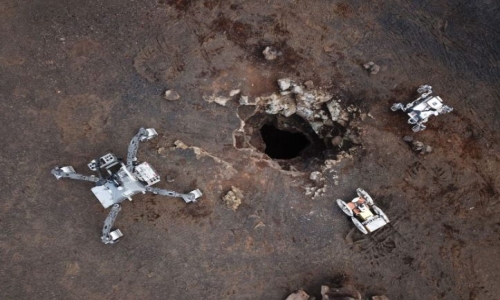


 11:44:1
11:44:1  2025-07-02
2025-07-02  816
816

Researchers have created a low-lead method to convert CO₂ into solid metal oxalates.
Researchers at the University of Michigan have contributed to the development of a method that transforms carbon dioxide, an industrial waste product that contributes to atmospheric pollution, into a valuable material: precursors for cement.
U-M chemist Charles McCrory and his research team, in collaboration with Jesús Velázquez’s lab at the University of California, Davis, and Anastassia Alexandrova’s lab at the University of California, Los Angeles, have created a process that captures carbon dioxide and converts it into metal oxalates. These compounds can then serve as key ingredients in the production of cement.
“This research shows how we can take carbon dioxide, which everyone knows is a waste product that is of little-to-zero value, and upcycle it into something that’s valuable,” said McCrory, associate professor of chemistry and macromolecular science and engineering. “We’re not just taking carbon dioxide and burying it; we’re taking it from different point sources and repurposing it for something useful.”
The research was spurred by McCrory’s participation in the Center for Closing the Carbon Cycle. 4C is an Energy Frontier Research Center funded by the U.S. Department of Energy, Office of Science, Basic Energy Sciences, and is led by Jenny Yang at University of California, Irvine. One of the goals of 4C is to explore methods for capturing and converting carbon dioxide into valuable fuels and products.
A Cleaner Alternative to Traditional Cement
The most common type of cement is Portland cement, which is typically made from limestone and minerals such as calcium silicates. Producing this Portland cement has a relatively large energy cost and carbon footprint, McCrory said. McCrory and colleagues were looking into ways to take carbon dioxide and convert it into materials that can be used for production of alternative cements.
One type of material that can be used as an alternative cement precursor are metal oxalates, simple salts. Researchers know that lead can be used as a catalyst—a substance that helps facilitate a chemical reaction—that can convert carbon dioxide into metal oxalates. But the process requires large amounts of lead catalysts, which is an environmental and human health hazard.
The 4C team was able to use polymers to control the environment immediately surrounding the lead catalysts, shaving the amount of lead needed in this process down to parts per billion—a trace impurity level of lead found in many commercial porous graphite and carbon materials.
McCrory specializes in controlling the microenvironment—the chemical environment and coordination environment—around catalyst sites. By controlling the microenvironment, McCrory can tune the activity of the catalyst. The researchers showed that by controlling the microenvironment surrounding the lead catalyst in the chemical reaction that converts carbon dioxide to oxalate, they can vastly reduce the amount of lead needed for the process.
Electrochemical Conversion Process
To produce the oxalate from carbon dioxide, the researchers use a set of electrodes. At one electrode, carbon dioxide is converted to oxalate, which is an ion dissolved in the solution. The other electrode is a metal electrode that’s being oxidized and releasing metal ions that bind with the oxalate ion and precipitate it out of solution as a metal oxalate solid.
“Those metal ions are combining with the oxalate to make a solid, and that solid crashes out of the solution,” McCrory said. “That’s the product that we collect and that can be mixed in as part of the cement-making process.”
Velázquez is a co-lead author of the study and associate professor of chemistry at UCD. His group originated the idea of using trace amounts of lead to drive the oxalate-synthesis reactions and examined the mechanisms behind the chemical reaction of carbon dioxide into oxalate.
“Metal oxalates represent an underexplored frontier—serving as alternative cementitious materials, synthesis precursors and even carbon dioxide storage solutions,” he said.
Alexandrova is also a co-lead author of the study and professor of chemistry and materials science at UCLA. Her team performed calculations to confirm the hypothesis that this mechanism would work.
“Catalysts are often discovered by accident, and successful industrial formulations are often very complicated. These cocktail catalysts are discovered empirically through trial and error,” Alexandrova said. “In this work, we have an example of a trace lead impurity actually being a catalyst. I believe there are many more such examples in practice catalysis, and also that this is an underexplored opportunity for catalyst discovery.”
Real CO₂ Capture With Practical Benefits
McCrory says once the carbon dioxide is converted into the metal oxalate solid, it won’t be rereleased into the atmosphere as carbon dioxide again under normal conditions.
“It’s a true capture process because you’re making a solid from it,” he said. “But it’s also a useful capture process because you’re making a useful and valuable material that has downstream applications.”
McCrory says researchers should be able to scale up one part of the process: researchers are working on electrolysis for carbon dioxide on a large scale. Next steps will be to further study how to scale up the portion of the process that produces the solid product.
“We are a ways away, but I think it’s a scalable process,” McCrory said. “Part of the reason we wanted to reduce the lead catalyst to parts per billion is the challenges of scaling up a catalyst with massive amounts of lead. It wouldn’t be environmentally reasonable, otherwise.”
Reality Of Islam |
|

A new NURBS

A research

Researchers
 9:3:43
9:3:43
 2018-11-05
2018-11-05
10 benefits of Marriage in Islam
 7:5:22
7:5:22
 2019-04-08
2019-04-08
benefits of reciting surat yunus, hud &
 9:45:7
9:45:7
 2018-12-24
2018-12-24
advantages & disadvantages of divorce
 11:35:12
11:35:12
 2018-06-10
2018-06-10
 6:0:51
6:0:51
 2018-10-16
2018-10-16
 9:30:2
9:30:2
 2021-11-12
2021-11-12
 3:42:22
3:42:22
 2021-12-24
2021-12-24
 2:34:48
2:34:48
 2022-01-18
2022-01-18
 6:14:17
6:14:17
 2018-06-21
2018-06-21
 9:50:37
9:50:37
 2023-02-28
2023-02-28
 12:10:56
12:10:56
 2022-11-17
2022-11-17
 11:34:48
11:34:48
 2022-06-29
2022-06-29
 5:41:46
5:41:46
 2023-03-18
2023-03-18
| LATEST |